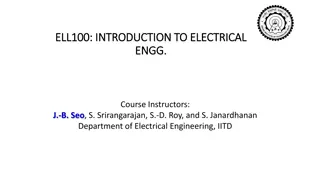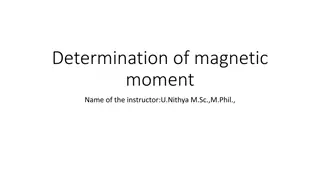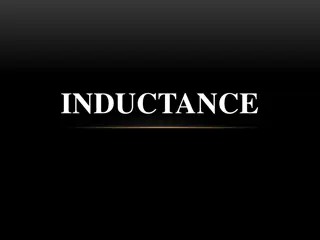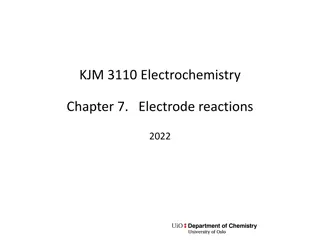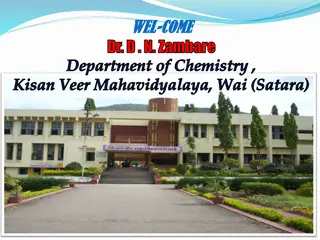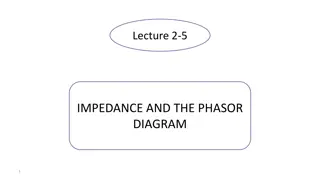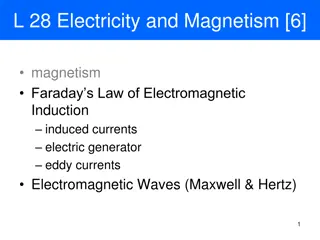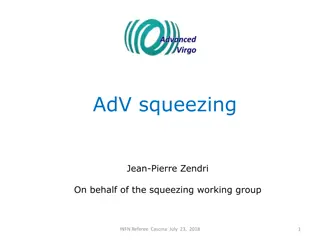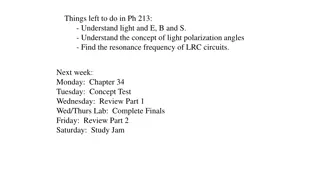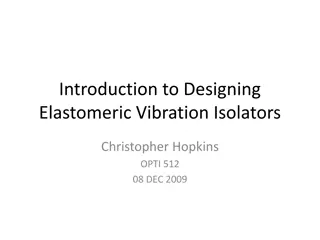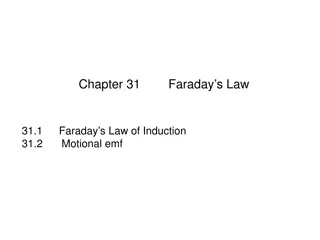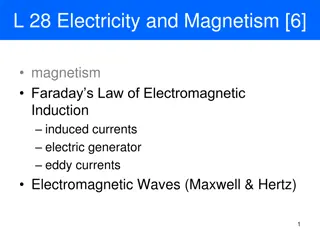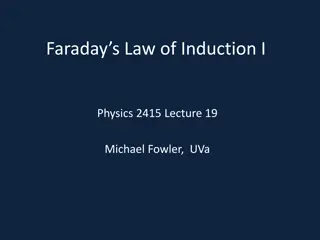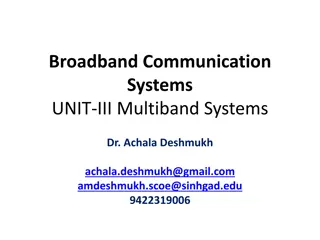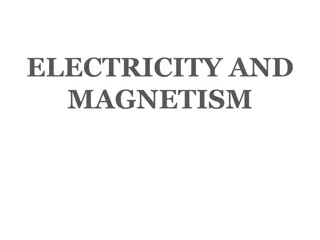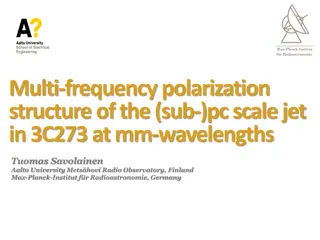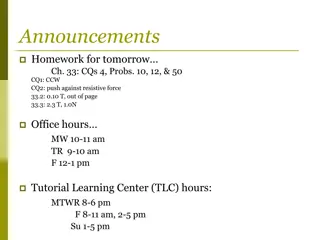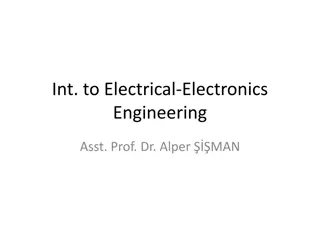AC Power Generation and Faraday's Law in Electrical Engineering
This course introduces students to AC power generation in electrical engineering. Concepts such as magnetic flux, induction of EMF through Faraday's Law, and examples like hydroelectric turbines and gasoline motors are covered. The course aims to provide a comprehensive understanding of how electric
5 views • 40 slides
Magnetic Moments and Susceptibilities in Materials
Determination of magnetic moment and susceptibility plays a crucial role in studying the magnetic properties of materials. This involves methods like Guoy balance for paramagnetic substances and observing weight changes for diamagnetic substances. The Faraday method, employing a quartz container in
5 views • 20 slides
The Derivation of the Nernst Equation and Its Implications
The Nernst Equation is derived to provide insight into membrane potential and its role in various health conditions like cystic fibrosis and epilepsy. This derivation involves combining diffusive flux, electric drift, and mobility terms, leading to a deeper understanding of membrane behavior. The Bo
14 views • 26 slides
Inductance in Electrical Circuits
Inductance in electrical circuits is a crucial concept defined by Faraday's law. It measures the opposition to changes in current, with inductors storing energy in their magnetic field. Mutual inductance and LC circuits further showcase the interconnectedness of inductance in electronic systems.
7 views • 8 slides
Electrode Reactions in Electrochemistry
Exploring electrode reactions in electrochemistry involves delving into Faraday's law, coulometry, and the importance of sustainable electrode reactions. These concepts help us understand how the quantity of charge passed affects the production or consumption of substances in electrode reactions. As
11 views • 27 slides
Corrosion and Electroplating in Chemistry
Delve into the fascinating world of corrosion and electroplating with a detailed exploration of their principles, processes, and methods of protection. Learn about atmospheric corrosion, immersed corrosion, chemical corrosion, underwater corrosion, and underground corrosion. Discover the electrochem
7 views • 36 slides
The VLA Sky Survey and Its Scientific Goals
The VLA Sky Survey (VLASS) is a comprehensive radio survey covering the sky visible to the VLA, conducted in three epochs with a focus on imaging galaxies, detecting transient events, exploring Faraday tomography, and uncovering hidden phenomena in the universe. The survey employs innovative strateg
3 views • 22 slides
VLASS Sky Survey and Galactic Science Highlights
The January 2016 AAS meeting discussed the VLASS Sky Survey, highlighting survey parameters, science drivers, and the potential for new discoveries in galactic science. Key topics included multiwavelength imaging, Faraday tomography, AGN and galaxy evolution studies, and the search for exotic system
4 views • 9 slides
Impedance and Phasor Diagrams in AC Circuits
Resistive elements in AC circuits exhibit zero phase shift between current and voltage due to their angles. Inductors introduce inductance when connected to AC sources, generating magnetic flux that affects conductor charges. Faraday and Lenz's laws explain induced voltage and current direction base
2 views • 18 slides
Magnetism: Faraday's Law and Induction
Explore the fundamental concepts of magnetism, including Oersted's and Ampere's discoveries, Faraday's Law of Electromagnetic Induction, and the generation of induced currents. Delve into the interplay between magnetic fields and currents as elucidated by Michael Faraday, and learn how changing magn
6 views • 24 slides
Advanced Virgo Squeezing Working Group Overview
The Advanced Virgo (AdV) project involves various activities related to squeezing technology, optical layouts, Faraday isolators, and electronics. The project includes components like the squeezer, clean room, detectors, telescopes, and alignment systems. The installation, commissioning, and status
1 views • 34 slides
E and B Fields in Physics 213
Explore concepts such as light polarization angles, resonance frequency of LRC circuits, Lorentz Force Law, Gauss Law, Faraday's Law, and Ampere-Maxwell Law in Physics 213. Delve into the interplay between electric and magnetic fields, and their effects on charged particles such as electrons and pro
4 views • 19 slides
Designing Elastomeric Vibration Isolators: Key Parameters and Configurations
Exploring the design aspects of elastomeric vibration isolators, including material selection, key design parameters, simple isolator configurations, spring rates, transmissibility, and shape factor calculations. Learn how engineered properties of elastomers can meet specific application requirement
4 views • 26 slides
Faraday's Law of Induction and Lenz's Law
Faraday's Law of Induction states that a changing magnetic field induces an electromotive force (emf) in a conductor, producing an induced current. Lenz's Law complements this by determining the direction of the induced current to oppose the change in magnetic field. This phenomenon is demonstrated
4 views • 23 slides
Magnetism: Faraday's Law and Electromagnetic Induction
Explore the fascinating world of magnetism and electromagnetism with insights into Faraday's Law of Electromagnetic Induction, induced currents, and the basic principles of magnetism. Discover how a changing magnetic field can produce a current and unravel the key concepts behind electromagnetic wav
4 views • 24 slides
Magnetic Flux and Induction Principles
Exploring the concepts of magnetic flux and electromagnetic induction through visual aids and explanations. Topics include the generation of current in coils, Faraday's law, Lentz's law, and the behavior of induced current with changing flux.
4 views • 36 slides
Faraday's Law of Induction and Electromagnets
Explore Faraday's Law of Induction, magnetic permeability, and the role of soft iron in strengthening magnetic fields. Learn about Faraday's idea of generating current from a magnetic field and his groundbreaking discovery of electromagnetic induction.
4 views • 25 slides
Multiband Systems in Broadband Communication
Explore the world of Wavelength Division Multiplexing (WDM) and its components, including fiber couplers, isolators, circulators, multiplexers, and demultiplexers. Learn the benefits of WDM technology such as capacity upgrade, transparency, scalability, and wavelength routing. Discover how WDM, CWDM
2 views • 51 slides
Electromagnetic Testing (ET) in NDT
Electromagnetic Testing (ET) is a crucial NDT method involving techniques like Eddy Current Testing (ECT) and Alternating Current Field Measurement (ACFM). It is used for crack detection, material thickness measurement, and more in various industries due to its sensitivity and immediate results. Des
2 views • 21 slides
Electricity and Magnetism Overview
Electricity and magnetism are essential in our daily lives, powering our homes and technologies. Discover the history of electricity, its properties, and the fundamental concepts of charges. Explore how inventors like Michael Faraday and Thomas Edison revolutionized the use of electricity.
5 views • 82 slides
Electromagnetic Induction Explained: Production of Voltage & Current
Electromagnetic induction is the process of generating an electromotive force in a conductor within a changing magnetic field. This phenomenon, first discovered by Michael Faraday, has various practical applications in electrical components such as inductors and transformers, as well as in devices l
2 views • 32 slides
Electromagnetic Laws and Phenomena
Ampere's Law states that the line integral of magnetic field around a closed path is proportional to the net current through the area enclosed by the path. Faraday's Law of Induction, Lenz's Law, and Motional Electromotive Force are essential concepts in understanding electromagnetic induction and m
1 views • 14 slides
Electric Machinery Fundamentals
Essential concepts in electric machinery including basic electricity, current flow, potential difference, Ohm's Law, Kirchhoff's laws, Faraday's laws, and more. Gain insights into terminologies, conductors, and insulators to enhance your understanding and application of electric machinery principles
3 views • 24 slides
Multi-Frequency Polarization Structure in 3C273 Jet
Study the multi-frequency polarization structure of the sub-pc scale jet in 3C273 at mm-wavelengths. Explore VLBI-scale Faraday rotation and EVPA differences. Analyze 43-86 GHz EVPA variations and depolarization patterns in the core region. Understand the polarimetry of 3C273 using VLBA data. Invest
3 views • 18 slides
Electromagnetic Induction in Electric Guitars
Electric guitars utilize electromagnetic pickups beneath the strings to produce sound through the process of electromagnetic induction. This phenomenon involves inducing an EMF in a coil of wire using a magnet, creating a current when the magnet moves relative to the coil. The concept of magnetic fl
3 views • 17 slides
Electromagnetic Induction in Generating Electrical Energy
Discover how electromagnetic induction is utilized to generate electricity, as explored by Michael Faraday. Learn about Faraday's law, factors influencing electromotive force, Lenz's law, and the principle of conservation of energy.
1 views • 10 slides
Faraday’s Law of Induction II
Faraday's Law of Induction, magnetic flux through a loop, Lenz's Law, electric generators, and more concepts explained with images and examples in Physics lecture.
1 views • 12 slides
Electric Field and Magnetic Flux Changes
Explore the concepts of electric field induced by changing magnetic flux, Faraday's law, inductance, and power transmission in this informative physics lecture. Learn about the generalized form of Faraday's law and the relationship between electric fields and potential differences.
1 views • 14 slides
Electromechanics: Magnetic Fields, Flux, and Faraday's Law
Explore the concepts of Ampere's Law, magnetic flux density, and Faraday's Law in electromechanics. Learn about the causes of magnetic intensity, the difference between magnetic flux and flux density, and the relationship between voltage and flux. Get insights into switching voltage waveforms and ha
2 views • 20 slides
Electromagnetic Induction: Understanding Lenz's Law and Faraday's Law
Dive into Chapter 33 to explore electromagnetic induction, including Lenz's Law and Faraday's Law. Understand how induced currents are generated in conducting loops and the principles behind magnetic flux changes. Prepare for homework on related problems and concepts. Office hours and tutorial suppo
1 views • 17 slides
Faraday's Law of Electromagnetic Induction
Explore the principles of Faraday's Law of Electromagnetic Induction explained by Dr. R. R. Mistry. Learn about electromagnetic induction, Faraday's two laws, Lenz's Law, and the relationship between magnetic flux and induced electromotive force in circuits.
1 views • 16 slides
Electrical-Electronics Engineering Insights: Ohm's Law, Faraday's Law, Kirchhoff's Circuit Laws
Explore fundamental concepts in electrical-electronics engineering such as Ohm's Law, Faraday's Law of Induction, and Kirchhoff's Circuit Laws. Understand the principles behind potential, current, voltage, and electromagnetic induction with practical examples and diagrams.
0 views • 10 slides
Faraday's Law of Induction and its Applications
Explore Faraday's Law of Induction and its significance in electromagnetic phenomena. Understand how induced electromotive force (EMF) is generated by changes in magnetic flux, and its applications in electrical generators and transformers. Dive into concepts like Lenz's law, moving loops in magneti
3 views • 21 slides
ThomX Diagnostics: Beam Measurements and Parameters
Explore the beam charge measurements, parameters, Faraday cups, and current transformers in the diagnostic report by Vincent Chaumat from LAL on 29th November 2018 for the ThomX project. Learn about the standard charge, pulse lengths, requirements, and integration procedures involved in the diagnost
0 views • 12 slides
Electrochemistry and Cell Potentials
Delve into the world of electrochemistry with a focus on galvanic and electrolytic cells, cell potentials, standard cell potentials, Faraday's Law of Electrolysis, and the relationship between Gibbs Free Energy and equilibrium constants. Explore how spontaneous chemical reactions generate electrical
5 views • 15 slides
STEREO Science Working Group Teleconference Summary
Get the latest updates from the STEREO Science Working Group's teleconference on March 21, 2014. Topics include agenda updates, upcoming events, financial status, senior review procedures, and more. Stay informed about Faraday rotation studies, spacecraft statistics, and superior conjunction discuss
5 views • 4 slides
Key Figures in Atomic Physics Discoveries
Explore the contributions of Dalton, Faraday, Crookes, Thomson, G.P. Thomson, Millikan, and Rutherford to atomic physics. From Dalton's atomic theory to Thomson's discovery of the electron and Millikan's oil-drop experiment, uncover the pivotal moments in the history of atomic science.
4 views • 24 slides
Electrochemistry and Cell Potentials
Delve into the world of electrochemistry with an overview of galvanic and electrolytic cells, Faraday's Law of Electrolysis, cell potentials, and the relationship between Gibbs Free Energy and the equilibrium constant. Explore how oxidation and reduction reactions occur in voltaic cells and the esse
2 views • 15 slides
Electromagnetic Induction: Faraday's Law Explained with Examples
Discover the principles behind Faraday's Law of electromagnetic induction through detailed explanations and real-life examples. Understand how changing magnetic flux and magnetic field variations induce currents, and explore the implications in scenarios like MRI machines. Dive into the concept of m
8 views • 9 slides
Radio Galaxy Faraday Rotation Study
Explore the mapping of Faraday Rotation in large radio galaxies using the POSSUM project. Investigate the polarisation of double radio sources, Laing-Garrington effect, RM stripes, and more in understanding magnetic fields and AGN contributions. Discover the Australian SKA Pathfinder project, EMUCAT
1 views • 25 slides
